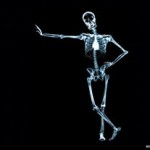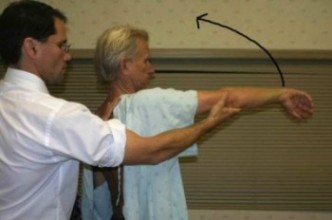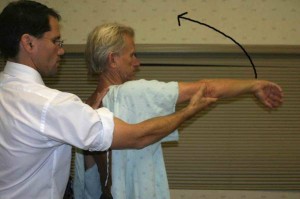Your Injury Diagnosis Is Important – So How Is it Done?
A person who knows what their injuries are, is more likely to be “involved “ in their care. And this… can dramatically improve the chances for a better recovery. The starting point is arriving at a Diagnosis (What’s Wrong). Knowing a bit of how that is done, helps to know better what’s injured, which is followed by a better understanding of what needs to be done to help, including the part that YOU will play. In our Minneapolis/St Paul Chiropractic office the diagnosis process begins with recording How You Feel – now and before the car accident. Then, How Everything Is Working – now and before the auto accident. Then, Medical and Family Health History. Then, a specialized examination tailored to your injury that includes:
Touching an injured area can reveal a lot about what’s happened. In the hands of a “professional toucher” like a Doctor of Chiropractic Medicine, are highly honed skills. Just as skilled as is a scalpel in the hands of a highly trained surgeon. By touching for example, an injured neck from a whiplash injury, increased warmth can indicate there is swelling or inflammation. This happens when tissues have been torn – even a little. Tight, taut muscle can indicate spasm, which is an involuntary tightening reaction of the muscle from injury to itself and/or the bones and joints it is attached to, making the muscle work too hard. Touching while moving the part can tell whether for example, a joint is “locked”, moving less than normal, or unstable because it is moving too much; all indications of injury to the joint. A painful response from a patient to touch is revealing in and of itself, especially if the same pressure is applied to other areas, and there is no pain.
Tests in this context are those that are performed by the doctor on the patient, or performed by the patient while observed by the doctor. Generally they are divided into 3 parts: Orthopedic, Neurologic and Chiropractic: Orthopedic (muscles, bones and joints) tests are simply pushing, pulling, stretching, compressing, moving and strength maneuvers to provoke or produce, decrease, or increase the same pains the patient is having. Basic neurological (the nerves, spinal cord and brain) tests check whether its 2 main activities of feeling and doing are working correctly or not. The feeling part, or “sensory”, can be checked with various tools for pain, light touch, heat, cold and pressure. The doing part, or “motor”, is checked in 2 main ways: a voluntary way (the person is doing it), and an involuntary way (the person’s body is reacting automatically to certain “stimulations”). Muscle strength testing is an example of voluntary. Tapping the reflexes at the knee, behind the ankle and arms with a reflex hammer is an example of involuntary. The leg and arm “jumps” when it is tapped in certain spots. Certain other reflex tests are also involuntary, and show how the spinal cord is working. Chiropractic tests are revealing of how specific joints are working – whether in the back, neck, arms, legs, jaws, etc. What’s being looked for is whether the joint is in an “ideal neutral position”, from which this starting position will allow normal movement. Along with this the joint is checked to see if it is moving normally actively (the person is doing it), and passively (the doctor is doing it). Overall weight-bearing balance or imbalance can be checked, meaning body weight is distributed evenly from side to side, or there is more weight on one side of the body than the other. This is important because the body operates with far less stress and dysfunction if it is symmetrical. Center of gravity testing can also be performed along with core strength testing. This is more of a neurological balance test, and the core strength part is about how much or little swaying is going on. The body does best the more centered it is and with little or no sway. Nerve “function” testing is also commonly performed with various instruments to assess temperature differences along the spine. This can tell if a nerve on one side or the other is irritated or inflamed.
 Imaging technology includes X-ray as a primary tool. This is done to see structural imbalances, spinal curvatures like scoliosis (curves extending out to one side or another rather than being straight), and increases or decreases in the front to back curves that are part of the overall “S” shape of the spine when seen from the side. Any of this information is very important when individual joints have been injured, because any of these “issues” add to the other in terms of being a problem. It can also reveal fractures, tumors, and bone disease like arthritis. So-called “stress” or bending X-rays can also provide valuable information about the effects of whiplash, like torn ligaments, abnormally moving bones, and unstable areas produced by injury. Enhanced imaging procedures include MRI and CAT Scans. MRI is more ideal for “seeing” soft tissues (muscle, tendon, ligament and disc). CAT scan is considered a more economical imaging process to better see bone and the abdomen. Both can be invaluable tools for looking into injuries to a greater degree, and can be necessary to really see an injury that X-ray can’t. These can also be “enhanced” by injectable liquids that add more contrast to the images that are produced.
Imaging technology includes X-ray as a primary tool. This is done to see structural imbalances, spinal curvatures like scoliosis (curves extending out to one side or another rather than being straight), and increases or decreases in the front to back curves that are part of the overall “S” shape of the spine when seen from the side. Any of this information is very important when individual joints have been injured, because any of these “issues” add to the other in terms of being a problem. It can also reveal fractures, tumors, and bone disease like arthritis. So-called “stress” or bending X-rays can also provide valuable information about the effects of whiplash, like torn ligaments, abnormally moving bones, and unstable areas produced by injury. Enhanced imaging procedures include MRI and CAT Scans. MRI is more ideal for “seeing” soft tissues (muscle, tendon, ligament and disc). CAT scan is considered a more economical imaging process to better see bone and the abdomen. Both can be invaluable tools for looking into injuries to a greater degree, and can be necessary to really see an injury that X-ray can’t. These can also be “enhanced” by injectable liquids that add more contrast to the images that are produced.
Special procedures can cover a wide array of diagnostic tests and exams performed by health care professionals skilled in specific areas. This can include electrical motor (doing) and feeling (sensory) tests to check specific nerves. A concussion may need to be evaluated by someone skilled in neuropsychology. A dental TMJ (jaw) specialist may need to check injuries to those joints. Radiologists skilled in injection procedures may be required for enhanced CAT scans or MRI’s, or a test called a discogram in which fluid is placed into a disc to see if it is injured. Surgical opinions may be necessary from orthopedists or neurologists, and neurologists may be necessary to check a spinal cord or brain injury. Lab testing can be valuable, as can an audiology exam for balance and inner ear injury. The list can go on, but all handled best if coordinated by the “primary” doctor involved with the person’s injuries. The idea here is to have a “coordinated team” who understand what the other “players” do, and who can communicate with each other.
A thorough, and accurate diagnosis is an important part of any health problem, and especially when it involves the complicated injury effects of a car accident.  Understandable explanations of it are equally important, to understand the important role that You’ll play in your own recovery. Both are stressed in our Minneapolis/St Paul Chiropractic facility for the reasons explained above. Always seek out thorough, skilled professionals if you’ve been injured in an auto, motorcycle or other motor vehicle accident.
Understandable explanations of it are equally important, to understand the important role that You’ll play in your own recovery. Both are stressed in our Minneapolis/St Paul Chiropractic facility for the reasons explained above. Always seek out thorough, skilled professionals if you’ve been injured in an auto, motorcycle or other motor vehicle accident.
By Dr. William T. Norlin Chiropractor in Minneapolis/St Paul, Minnesota












